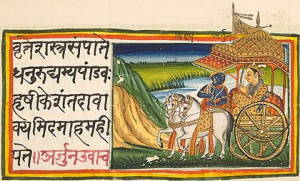Language/Sanskrit/Grammar/How-to-Use-Have
Hi Sanskrit learners! 😊
In this lesson, we will focus on how to use "Have" in Sanskrit. Understanding the use of "Have" is crucial to building complex sentences and expressing yourself in various contexts.
What is "Have" in Sanskrit?
"Have" in Sanskrit translates to आस (aasa). It is a verb that can be used both in the present and past tense. From a grammar perspective, it is an auxiliary verb that helps to form perfect tenses in Sanskrit.
How to use "Have" in Sanskrit
In Sanskrit, "Have" is used to form the present perfect and past perfect tense. The present perfect tense is used to talk about actions that started in the past and are still happening. The past perfect tense is used to talk about actions that were completed before another action started. Below are two examples to illustrate the use of "Have" in Sanskrit:
| Sanskrit | Pronunciation | English |
|---|---|---|
| बालकः लेखनम् आसन्। | Baalakah lekhanam aasan. | The boy has been writing. |
| तेषाम् पुस्तकाणि गृहे आसन्। | Teshaam pustakaani gruhe aasan. | Their books had been at home. |
Conjugation of "Have"
"Have" in Sanskrit can be used with different pronouns to form complex sentences. The conjugation of "Have" varies depending on the gender and number of the subject. Below is a table that shows the different forms of "Have" in Sanskrit:
| Person | Sanskrit | Pronunciation | English Translation |
|---|---|---|---|
| First Person Singular | अहम् आस्मि | Aham aasmi | I have |
| Second Person Singular (male) | त्वम् आस्ति | Tvam aasti | You have (singular, male) |
| Second Person Singular (female) | त्वम् आस्ति | Tvam aasti | You have (singular, female) |
| Third Person Singular (male) | सः आस्ति | Sah aasti | He has |
| Third Person Singular (female) | सा आस्ति | Saa aasti | She has |
| First Person Plural | वयम् आस्महे | Vayam aasmahae | We have |
| Second Person Plural | यूयम् आस्थ | Yuyam aastha | You have (plural) |
| Third Person Plural | ते आस्न्ति | Te aasnti | They have |
Examples in Dialogue
Let's have a dialogue to see how "Have" is used in context:
- Person 1: किमर्थं तिष्ठसि? (Kimartham tishthasi?) - Why are you standing?
- Person 2: वायम् संगीतपुस्तकं अधीतवन् आस्मः। (Vayam sangitasustakam adhitaavan aasmah) - We have been studying a music book.
- Person 1: त्वम् कुत्र आस्ति? (Tvam kutra aasti?) - Where are you?
- Person 2: मम बहुमूलफलमूल्यादयः गृहे आसन्। (Mama bahumuulaphalamulyaadayah gruhe aasan) - My fruits and vegetables were at home.
Conclusion
In this lesson, we have learned how to use "Have" in Sanskrit to form perfect tenses. Remember that practice makes perfect, so keep using "Have" in various contexts to become fluent in Sanskrit. To improve your Sanskrit Grammar, you can also use the Polyglot Club website. Find native speakers and ask them any questions!
➡ If you have any questions, please ask them in the comments section below.
➡ Feel free to edit this wiki page if you think it can be improved. 😎
Videos
How to study Sanskrit | Highschool Sanskrit Grammar - YouTube
Related Lessons
- Negation
- Give your Opinion
- Adjectives
- Questions
- How to Use Be
- Future Tense
- Conditional Mood
- Plurals
- Gender

